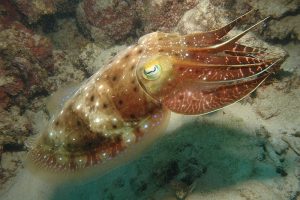
A team of researchers with Cambridge University has determined that the common cuttlefish has the cognitive ability to postpone the instant satisfaction that can come from an immediate reward if it holds out for a more attractive prize that is made available later, through a test originally designed to study the development of delayed gratification in human children. Although the cephalopods are capable of this forward-thinking ability, the researchers are unsure as to why these invertebrates have developed this particular cognitive capacity, as they don’t display the same social complexity or tool use behaviors that the more complex vertebrates that make use of delayed gratification do.
Originally intended to study the development of cognition in human children, the Stanford marshmallow experiment was designed to study an individual’s ability to employ the concept of delayed gratification, the ability to put off receiving an immediate reward for a certain amount of time in order to obtain a more valuable one. Developed by Stanford University psychologist Walter Mischel in 1972, the study involved placing a child, between three and five years old, in a room with a treat, such as a marshmallow; the subjects were told that if they abstained from eating the treat for fifteen minutes they would receive an even better treat as a reward.
This experiment has been adapted to illustrate the delayed gratification ability found in some primates, corvids (crows and ravens), and sometimes in dogs, indicating that numerous non-human species are capable of cognitive abilities that involve future planning. However, the animals that previously passed the test were exclusively complex vertebrate species, at least until 2020 when an invertebrate—Sepia officinalis, better known as the common cuttlefish—passed the test.
However, the experiment’s results were called into question when the idea that the delay in accepting a reward might have been due to instinctual foraging behavior ingrained into the cephalopods over the course of the species’ evolution. This resulted in a modification to the experiment that involved training six individual cuttlefish to recognize symbols that were placed on the doors to transparent chambers that held the rewards offered by the experiment: a circle indicated a door that would open freely; a door marked with a triangle would open after a ten-to-130-second delay; and a square meant the door was permanently locked, making the reward inaccessible.
The test used two types of food as a reward: a piece of raw king prawn was used as the immediate reward, while a live grass shrimp—a much preferred snack to the cuttlefish—was used as the delayed prize. The prawn meat was placed in the freely-openable circle-adorned door; the live shrimp in the delayed triangle chamber; and the locked square door was used in a control group. Whenever the cuttlefish in the main test group took the prawn meat, the shrimp in the triangle chamber was removed, indicating that the delayed reward was no longer an option.
The researchers found that all of the cuttlefish in the test group ignored the immediately-available prawn piece, preferring to wait out the time it took to obtain the much tastier shrimp, while the control group, faced with a symbolic indication that the shrimp wasn’t on the menu at all, ignored the otherwise inaccessible top-shelf choice altogether and settled for the fast food that was on hand.
“Cuttlefish in the present study were all able to wait for the better reward and tolerated delays for up to 50-130 seconds, which is comparable to what we see in large-brained vertebrates such as chimpanzees, crows and parrots,” explained University of Cambridge behavioral ecologist Alexandra Schnell, who led the studies.
A second experiment, designed to test how adept the cuttlefish were at learning, was conducted on the same individuals involved in the marshmallow test. In this experiment, the cuttlefish were shown plastic cards that were either gray or white (cuttlefish are color blind), with one of the cards being associated with a reward; after the individual subjects began to consistently pick the card associated with the treat the researchers swapped the cards, meaning the cephalopods needed to re-learn which card was which. Interestingly, the researchers found that the individual cuttlefish that were able to adapt to the change in cards the fastest were also the same individuals that were able to wait the longest in the delayed gratification test
Although this demonstrates these cephalopods’ concept of self-control, it’s not clear as to why they have developed this ability: in more complex vertebrates, the ability is useful in regards to the planning needed for tool use or food caching, but neither of these behaviors are employed by cuttlefish; however, the study team suspects that it may be related to how the creatures forage for food.
“Cuttlefish spend most of their time camouflaging, sitting and waiting, punctuated by brief periods of foraging,” Schnell elaborated.
“They break camouflage when they forage, so they are exposed to every predator in the ocean that wants to eat them,” she continued. “We speculate that delayed gratification may have evolved as a byproduct of this, so the cuttlefish can optimize foraging by waiting to choose better quality food.”
Subscribers, to watch the subscriber version of the video, first log in then click on Dreamland Subscriber-Only Video Podcast link.
In the last couple of years I’ve seen some fascinating things about cuttlefish on PBS and other nature shows. They are amazing…and beautiful. We are so far behind in recognizing the consciousness of our fellow beings on our planet. Theirs is different, but it’s there! They could be our teachers for understanding the consciousness that exists elsewhere in our Universe.
A number of Avian species possess the same qualities to at least an equal degree .